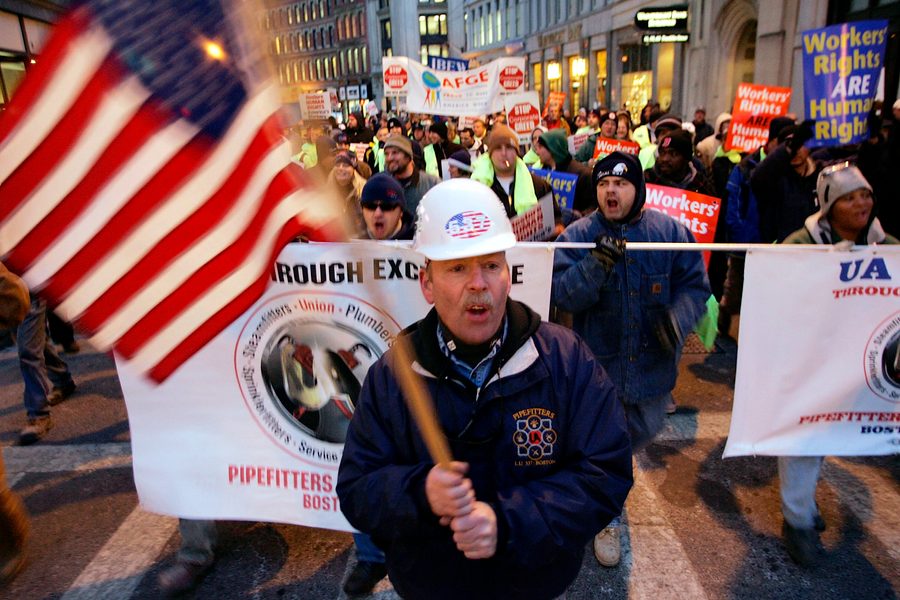The AFL-CIO's Official New Goal: Continued Decline
The union federation’s new organizing plan aims low. Very low.
Hamilton Nolan

The single best measurement of the strength of labor unions is union density — the percentage of the total workforce that is unionized. Nothing makes the crushing decline of unions in America more intelligible than the fact that at their height in the mid-20th century, one in three workers was a union member, and today, scarcely one in 10 is. All of the downstream damages to the working class — lower relative wages, higher economic inequality, less political power — flow from this decline.
We know, therefore, that increasing union density is the labor movement’s most pressing task. Thus, the AFL-CIO — America’s largest union coalition, representing the vast majority of our nation’s union members — unveiled, at its convention in Philadelphia, with much fanfare, a brand new formal goal: to see to it that union density keeps declining for the next decade.
Allow me to be very specific. Liz Shuler, the newly elected president of the AFL-CIO, announced from the convention stage the formation of the “Center for Transformational Organizing,” with the stated goal of organizing at least 1 million new working people in the next 10 years. “We will develop, implement and scale powerful campaigns for unprecedented union growth,” Shuler said. This was presented as a bold new statement that the AFL-CIO is, at last, putting organizing on the front burner. The convention’s motto, after all, is “Building the Movement to Meet the Moment.”
A million new members. Kinda sounds like a lot? Right? Well my friends, let’s do a little quick math. One decade ago, in 2011, the Bureau of Labor Statistics (BLS) says there were 14.8 million union members in America, for a union density of 11.8%. In 2021, the most recent year on record, there were 14 million union members, for a density of 10.3%. In raw numbers, 800,000 union members were lost in the past decade. So adding a cool million in the next decade seems pretty good. Right?
No. According to the BLS, America will add 12 million jobs during the 2020s decade, with total employment rising to 165.4 million by the year 2030. One million is only 8% of those. If we very conservatively estimate there will be 166 million total workers by 2032, and we add a million new union members, there would be 15 million union members a decade from now, for a union density of less than 10%. Which is to say: The AFL-CIO’s highly touted organizing plan would represent a continued decline of unions for the next decade, and an acceptance of single-digit union density, which is the last stop before true irrelevance. Rather than “unprecedented union growth,” as advertised, this would represent extremely well-precedented degrowth.
At a press gaggle yesterday evening, I asked Liz Shuler and Fred Redmond, the brand new leadership team of the AFL-CIO, about this projection. “It’s a target, it’s a threshold, that we could get every union in the federation to buy into, which is a feat in and of itself,” Shuler said. “The federation has never been seen as the place that does the organizing, it’s the unions themselves. And so if the federation sets a goal, it’s a hollow goal, if you don’t have the unions behind you 100%.”
This is true, as far as it goes, but it is nothing more than a discussion of who is to blame — the AFL-CIO, or the member unions — when union density goes down. If Shuler truly wants to be more ambitious, this would be a good time to throw some intransigent, lazy union leaders under the bus: “We would love to have put forward a bigger number, but unions X, Y and Z were unwilling to do so.” Then, activists inside the individual unions could deal with the problem. Without that sort of transparency, though, all we have is shared blame. And ultimately, it all means nothing to working people who are left without unions.
Fred Redmond, the former head of the Steelworkers Union who is now Shuler’s second in command, pushed back by saying that the AFL-CIO did not care whether the growth of unions occurred inside or outside itself, as long as it occurred. “I don’t want to give the perception that this whole thing is about trying to increase the AFL-CIO. We want that to happen. But if it don’t happen, okay. We’re trying to build a working movement. This is a movement that we think is bigger than the AFL-CIO.”
Okay. The AFL-CIO says it represents 12.5 million union members, the vast majority of all union members. It would seem unlikely, at the very least, for the bulk of union growth in the next decade to happen outside of the AFL-CIO. But hey, sure, I’m open-minded. The Amazon Labor Union is independent, for example. Maybe that model will take off. So, I asked, are they in fact asserting that the majority of the next decade’s union growth will happen outside of the AFL-CIO, and the 1 million they plan to add will only be a small fraction of the total?
No, said Shuler and Redmond. That is not their argument. (Others might say that there could be growth in already unionized workplaces — but that number, representing the employment growth or attrition at existing businesses, is just as likely to go down as it is to go up. And besides, that sort of hiring is controlled by business, not by labor. The only way for unions to ensure that union density goes up is by new organizing). The plain facts are that the nation’s largest body of organized labor has announced a goal that represents a decline in the single most important measure of union strength, and there is no reason to believe that some outside Organizing Fairy will ride to the rescue to save workers somewhere else.
Look, I want to be fair to the AFL-CIO. It is good that they are trying, at long last, to feature new organizing as a high profile priority, and it is good that they are trying to set a goal. I believe that they believe that is important, in a (too) philosophical sense. Randi Weingarten, the head of the American Federation of Teachers, the AFL-CIO’s largest union, took this view in another press gaggle last night: “It’s important to put a number out there,” she said. “Is it too low? Of course it’s too low!” Her point was that the decline of unions has been more than a half century in the making, and any reversal of that would take a long time, and the mere act of having a goal that all of these dozens of disparate unions would agree to was a worthy first step.
The problem is that the goal sucks. It is like a lethargic person finally joining a gym, and setting themself the goal of bench pressing one pound. Yes, it is achievable. But it won’t do them much good. Likewise, watching union density continue to decline and then congratulating ourselves because that was our stated goal is arguably even more sickening than not having any goal at all. It is an implicit acceptance of the very thing we are supposed to be most strenuously against.
If we are setting goals, we need to be thinking in terms of doubling union density. That would bring us back to where we were in 1980, before Reaganism started eating us all alive. That, of course, will be a difficult task, so let’s imagine that we set as a goal only half of that — getting union density up to around 15%. That would imply organizing, from today’s base, at least another 7 million workers. The AFL-CIO is shooting for one-seventh of that, in 10 years. But hey, maybe they will exceed the goal! We are adopting the strategy of a student who tells their mom, “My goal for math class is a D this year. But I might even beat it!”
It is a problem that the leadership of the AFL-CIO only believes that it can get its member unions to agree to a target of 1 million new workers in a decade. It is a problem that the unions themselves can apparently only be convinced to agree to such a modest target. It is a problem at the top of the federation, and at the top of individual unions. And who will suffer as a result? Primarily, the millions of unorganized working people who desperately need the protection of unions, but will not get it, because the labor movement as it is currently constituted has no will or ability to make such a thing possible.
On stage in Philadelphia yesterday morning, a procession of workers who are currently engaged in their own organizing fights took the stage. There were Amazon workers, and flight attendants, and public defenders, and more. Each of them, like all of us who have organized, was taking a personal risk, in the belief that they could achieve something righteous. Millions of regular ass people have, at one time or another, put their own livelihoods on the line in order to win their unions. It is not too much to ask that the leaders of the labor movement be as brave as the people they work for.
Hamilton Nolan is a labor writer for In These Times. He has spent the past decade writing about labor and politics for Gawker, Splinter, The Guardian, and elsewhere. More of his work is on Substack.








